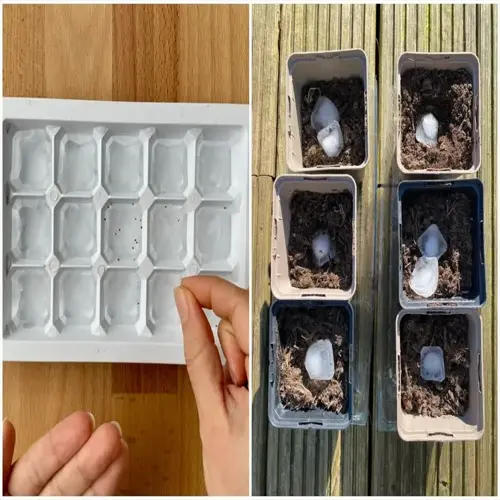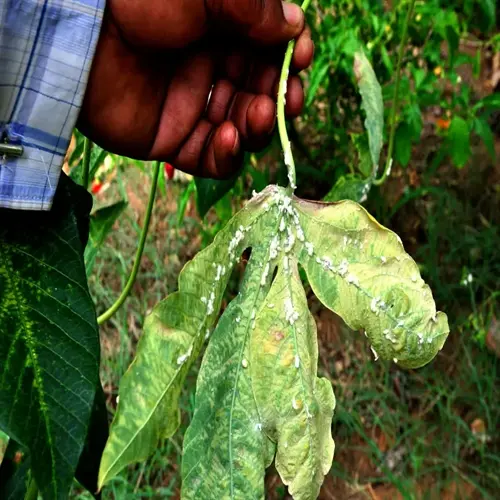8 Common Problems With Tomato Plants and Solutions

Written by
Liu Xiaohui
Reviewed by
Prof. Martin Thorne, Ph.D.Detecting typical issues with tomato plants is essential for preventing losses.
Blossom end rot isn't just poor calcium, it generally means inconsistency in watering.
Plan to deep soak your tomatoes two to three times each week, instead of daily watering.
Always test the soil pH prior to adjusting it for nutrient problems.
Handpicking hornworms and lime with Bt spray are organic options for controlling these pests.
Wilting can indicate either overwatering or disease; check the soil moisture first.
Article Navigation
You have lovingly tended to your tomato seedlings. You have encouraged them to develop into healthy, green plants. And all of a sudden, you see leaves turning yellow or dark staining on the fruit. Many gardeners find themselves dealing with these issues with tomato plants. It's a bummer. The great news is that these are very typical issues and problems that can be dealt with. Early intervention can prevent you from losing your entire crop!
The key is quickly noticing the signs of trouble. Wilting leaves or slow/poor growth are signs that something's wrong. We will focus on non-disease-related issues here. This would include insect pests, inadequate nutrients, and improper watering. Each of these can usually be solved quickly and easily, and does not require any special training.
This guide offers you effective solutions. You'll become adept at quickly identifying symptoms. You will also get practical fixes for each of the issues. Most issues can be resolved effectively. Plants can be restored to health. You can harvest again.
Environmental Stress Factors
The summer heat can be more damaging to tomatoes than you think. Most home gardens suffer when temperatures rise above 90°F. The leaves curl tight. The flowers drop without creating fruit. Most people experience this in nearly 80% of home gardens. Things you can do about it exist. Put on shade cloth in the hottest part of the afternoon. Use thick mulch to keep the roots cool and moist. Water deeply in the hottest part of the day.
Cold stress usually begins with the enthusiastic spring planting. Tomato plants experience stress at anything below 50°F. You may notice purple leaves or a stop in growth as a red flag, but generally, it means you started too early. Be patient and wait until the soil temperature rises above 60°F before you transplant. If you're expecting nights to be cold, cloches can keep your seedlings warm. Attention to microclimates is important, too. Planting close to a sun-warmed wall helps buffer cooler air, too.
Humidity encourages fungal diseases. You can minimize your risk. Plant 24 36 inches apart. It helps airflow. Always water in the morning. Leaves dry out quicker. Do not wet leaves directly. Removes humidity from around the plants. Your tomatoes will be healthier in sticky weather.
Notice disparities between shaded and sunlit areas. Tomatoes in direct sunlight need more frequent watering. Tomatoes in some shade may escape heat stress but become lanky and leggy. Rotate pots for uniform sun exposure. Recognize the unique microclimates of your yard or garden. Adapt care to each plant's specific location.
Watering Issues
Thorough soaking is preferable to shallow watering for tomato roots. Water reaches a depth of 6-8 inches and is soaked thoroughly. Watering shallowly causes weak roots near the surface. Provide 1-1.5 gallons every two to three days for each plant. This develops drought-resistant roots, so that your tomatoes can tap into deeper soil moisture during dry periods.
Blossom drop indicates drought stress. Last summer, my neighbor lost her entire early crop. My neighbor lightly watered her crop every day of the week. During hotter weather, my neighbor's plants dropped flowers regardless of watering. Watering deeper prevents this. Maintaining consistently moist soil allows the roots to access cooler, moist soil, consistently wet soil results in a consistent crop.
Drip irrigation is efficient with water and reduces disease. It sends water directly to the root zone with 90% efficiency. Sprinkling water loses up to 50% of its benefit due to evaporation and wet foliage. Wet foliage creates fungal disease issues. Years ago, I switched to a drip line, and my plants remain happy throughout the humid summer.
Cracking of fruits occurs after sudden watering following a drought. When tomatoes take up too much water too quickly. The skin cracks under pressure. Maintain a relatively even moisture level in your soil to prevent this from happening. After a drought, water slowly over two days. A mulch helps maintain a stable moisture level in the soil.
Soil and Nutrient Deficiencies
Leaf color changes can indicate more specific nutrient deficiencies. Yellowing of older leaves indicates nitrogen deficiency. Yellowing between the veins of mature leaves indicates magnesium deficiency. Purple undersides of the leaves show that there is a phosphorus deficiency. My purple leaves turned green last year after I applied bone meal.
Soil pH regulates nutrient availability. Below 6.0, phosphorus becomes fixed. Above 7.0, iron becomes unavailable. Make it a point to test your soil pH annually. My soil is slightly acidic. I add lime to get it to around 6.5. This range enables plants to utilize all nutrients effectively.
Be cautious when selecting amendments for phosphorus. Bone meal gets released quickly but encourages leaching. Compost will release slowly and build soil structure. I use composted manure and bone meal. The compost feeds the microbial biomass. Bone meal provides immediate phosphorus for my flowering plants.
Blossom end rot is primarily caused by calcium deficiency. Dark, leathery patches ruin the bottoms of the fruit. Adding consistent water during hot temperatures also allows better calcium uptake. Gypsum adds calcium without changing the pH levels. I apply at planting time. This keeps the sweet rot at bay on your tomatoes.
Pest Infestations
Hornworms and stink bugs account for the majority of what can be claimed as visible fruit damage. Hornworms destroy leaves literally overnight to leave just the bare stem behind. Stink bugs inject a chemical into the flesh of the fruit, producing white corky blemishes under the skin of the tomatoes. When tender fruit can be damaged, inspecting plants daily for these guys is important for prevention. Handpick before they wreck your crop.
Small holes in leaves indicate the presence of flea beetles. They are quick to jump when disturbed. A magnifying lens will capture them. They are particularly harmful to young plants. You can use row covers to protect seedlings. Sticky traps capture adults. Neem oil sprays target significant infestations while leaving beneficial insects unharmed.
Pests are active on different schedules. Aphids congregate on new growth, eating sap during the day. You see the sap-sucking activity. Cutworms are active at night and cut the stems off at the soil surface. Check the seedlings after dark with a flashlight. Another way to protect seedlings is with cardboard collars.
Companion planting develops natural defenses. Basil repels thrips and whiteflies - plant it between your tomatoes for a natural pest control solution. Marigolds deter nematodes with their root exudates - I plant French marigolds around my beds. This decreased pest pressures without pesticides.
8 Common Problems With Tomato Plants
Blossom end rot is the number one tomato problem. Dark, leathery patches form on the bottoms of the fruit, a calcium deficiency along with irregular watering, causes this. The best way to prevent it is to maintain consistent soil moisture and use cultivars with tolerance or resistance, such as Mountain Fresh. Gypsum could also be added at planting, which would enhance calcium insurance.
Problems with leaves can be baffling for the grower, brown spots surrounded by a yellow halo signal a problem with fungus. Overall yellowing of leaves of a plant indicates a lack of nitrogen. I'd group these two as they both affect the leaves. Enhancing air circulation between plants will help. Apply a balanced fertilizer every 4 weeks to maintain healthy, green leaves.
Fruit cracking occurs after sudden heavy rain. Radial splits destroy ripe tomatoes. You can avoid this with consistent, even watering and a 3-inch mulch. Wilted plants need to be assessed. Start by testing soil moisture. Overwatered roots will be brown and slimy. Fix drainage right away.
Excessive heat can lead to poor fruit set. Flowers can drop if they are not pollinated. Use shade cloth if the temperature exceeds 90°F, Hand-pollinate with a soft paintbrush. Catfacing causes ugly scars on the fruit. Wait until the soil warms to over 60°F to plant. To avoid catfacing, select only smooth varieties, such as Homestead 24.
5 Common Myths
Blossom end rot is fixed by adding more calcium to the soil through supplements or eggshells.
While calcium deficiency contributes to blossom end rot, inconsistent watering is the primary cause. Calcium supplements won't help if water fluctuations prevent nutrient uptake. Maintain even soil moisture with drip irrigation and mulch instead. Soil tests should confirm deficiency before adding amendments to avoid nutrient imbalances.
Tomato plants require the soil to be watered every day to avoid wilting, and generate juicy fruit.
Watering the plants shallowly for several days will cause the roots to grow weak and lead to disease. Watering until completely soaked 2-3 times a week (1-1.5 gallons per plant) promotes deep roots that can endure a drought. Water the soil only when the top 2-3 inches of soil are dry. Overwatering will suffocate the roots and wash nutrients from the soil resulting in yellowing leaves and blossom drop.
Removing all foliage through heavy pruning maximizes tomato yields by redirecting energy to fruit production.
Excessive pruning reduces photosynthesis and exposes fruit to sunscald. Remove only lower leaves touching soil to prevent disease spread. For indeterminate varieties, prune suckers sparingly. Determinate tomatoes shouldn't be pruned at all. Retain enough foliage to shade fruit and sustain growth throughout the season.
Understanding that chemical pesticides are vital to control pests that attack tomato plants like hornworms and aphids.
Because the pesticides harm beneficial insects, natural predators of pests. You can handpick hornworms every day, and you can use Bacillus thuringiensis (Bt) insect as a caterpillar pesticide on your tomatoes. You can spray aphids with soap or neem oil. You can use ladybug and lacewing larvae as aphid predators. Companion planting with basil would repel thrips, and marigolds would deter nematodes without using pesticides.
Droopy tomato plants are always a sign of dehydration. Watering ASAP is necessary to prevent lasting injury.
Droopiness can also mean overwatering, diseases, like Fusarium wilt, or damaged roots. Always check the soil moisture first: if it is soggy - improve drainage. Look at the stems: brown streaks are an indicator of a fungal infection. Yellow leaves can indicate overwatering, vascular discoloration leads to diseased plants; vascular discoloration\will be brown or black in the stems.\ Don't water again until the soil is deep dry, at least 2-3 inches deep, to avoid root rot.
Conclusion
Almost all tomato issues come from water, nutrient, or climate stress. Look for early warning signs: changes in leaf, stunted growth. Prevention is key to ensuring small problems don't escalate into large crop failures. Your attention to detail defines the difference between a successful harvest and regret.
Keep these three solutions in mind: Water consistently with deep watering. Test your soil prior to adding nutrients. Look for pest issues every day. If you develop these three habits, you'll avoid most of the problems you might encounter. They also help build resilience in your plants, which can ameliorate unanticipated circumstances or challenges throughout the growing season.
Even the most serious concerns can usually be remedied. Wilting plants and plants suffering from pests often recover if drainage problems are solved. Plants suffering from a nutrient deficiency can benefit from green-up beverages and soil amendments. If you take care of your tomatoes, they can recover in a matter of weeks.
Don't be disheartened at setbacks. Most of the problems with your tomatoes are solvable in a single season. Put into practice what you learned here. Make your adjustments. Next year's feast will be overflowing baskets of well-grown tomatoes from your own garden.
External Sources
Frequently Asked Questions
What are the visual signs of an unhealthy tomato plant?
Unhealthy tomato plants show distinct symptoms including yellowing leaves, dark leathery spots on fruit bottoms, purple-tinged foliage, wilting stems, cracked fruits, and stunted growth. These indicate issues ranging from nutrient deficiencies to diseases or watering problems.
How can I properly water tomato plants to prevent common issues?
Water tomatoes deeply 2-3 times weekly with 1-1.5 gallons per plant, allowing soil to dry slightly between sessions. Always water at soil level in morning hours to prevent fungal diseases and avoid inconsistent moisture that causes fruit cracking.
Are household items like baking soda effective for tomato care?
Baking soda can help prevent fungal diseases when sprayed on leaves, but isn't a cure for root problems. For fundamental issues like blossom end rot or nutrient deficiencies, focus on soil amendments and consistent watering instead of quick fixes.
What causes tomato leaves to curl or turn yellow?
Leaf curling or yellowing results from multiple factors:
- Overwatering leading to root suffocation
- Nitrogen or magnesium deficiencies
- Viral diseases transmitted by pests
- Extreme heat stress above 90°F (32°C)
Can tomato plants recover from severe stress or damage?
Most stressed plants recover if issues are addressed promptly. Correct watering habits, balanced fertilization, and pest removal typically restore health within 3-4 weeks. Remove unrecoverable parts but keep main stems intact for regrowth.
How do I diagnose nutrient deficiencies in tomatoes?
Identify deficiencies through leaf patterns:
- Yellow older leaves indicate nitrogen shortage
- Purple undersides signal phosphorus deficiency
- Brown leaf edges mean potassium is needed
- Yellow between veins suggests magnesium lack
What are organic solutions for common tomato pests?
Effective organic pest controls include:
- Handpicking hornworms daily
- Neem oil sprays for aphids
- Diatomaceous earth barriers for stink bugs
- Companion planting with basil or marigolds
Why do tomato fruits develop dark spots or cracks?
Dark bottom spots indicate blossom end rot from calcium imbalance and inconsistent watering. Fruit cracking occurs due to sudden moisture changes after dry periods. Both are preventable with even watering schedules and 2-3 inch mulch layers.
How can I prevent diseases in tomato plants?
Disease prevention requires:
- Morning-only watering to keep foliage dry
- 24-36 inch spacing for airflow
- Copper fungicide applications at first signs
- Annual crop rotation in garden beds
Are eggshells or coffee grounds beneficial for tomatoes?
Eggshells add calcium but break down slowly - use gypsum for faster results. Coffee grounds provide nitrogen but must be composted first. Both should supplement, not replace, balanced fertilization based on soil tests.

